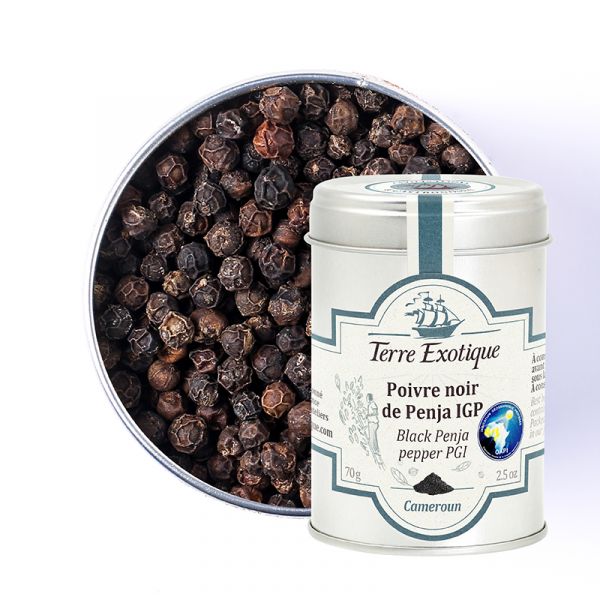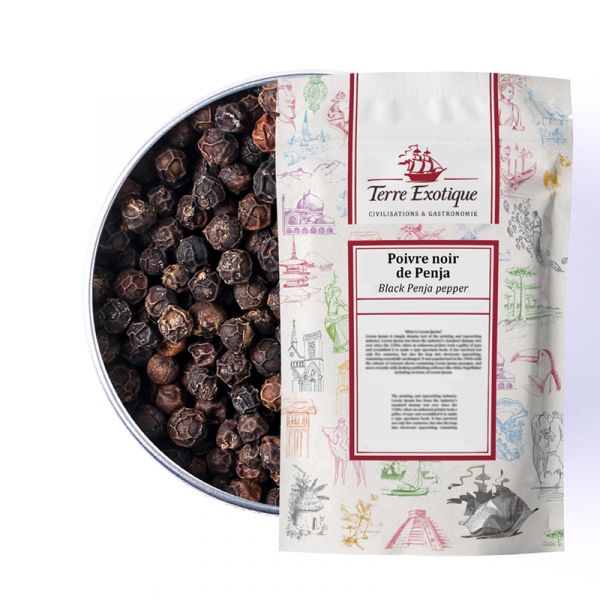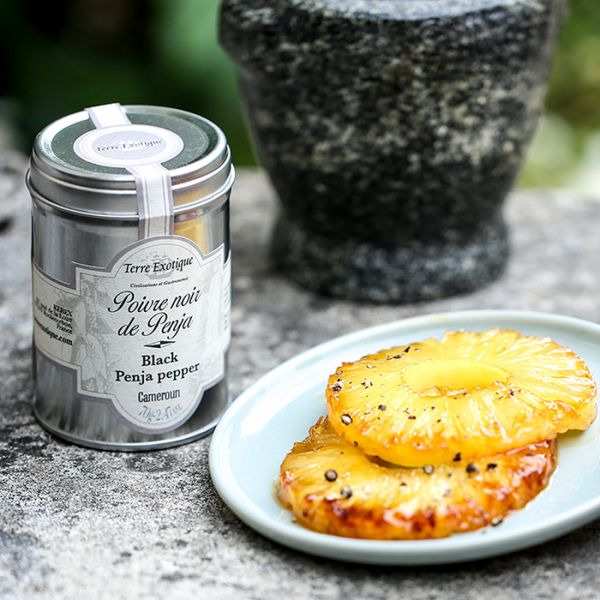





Where to use Penja black pepper
Explore its fruity balsamic flavours
Penja black pepper will enchant all your sweet and savoury recipes! We suggest you grind it very finely and only add it just before serving to release its full aromas.How to get the best from your Penja black pepper
Our recipe ideas for Penja black pepper:• Oysters with coriander and black pepper: add 1 teaspoon of ground Penja black pepper to the sauce (check out our recipe below);
• Warm goat’s cheese canapés with Penja pepper: sprinkle your canapés with a few pinches of ground black pepper as soon as they come out of the oven;
• Duck breast with flat peaches: sprinkle a few pinches of ground black pepper over your duck breasts before serving;
• Summer vegetable tart: courgettes, tomatoes, peppers: give a few twists of your pepper mill filled with Penja black pepper and enjoy;
• Caramelized pears with honey and a hint of pepper: caramelize your pears then add a few twists of your pepper mill filled with Penja black pepper;
Oysters with coriander and black pepper
Ingredients For the vegetables:1 carrot;
1 clove of garlic;
½ white onion;
2 branches celeriac;
½ fennel;
1 tablespoon Terre Exotique olive oil;
½ teaspoon Terre Exotique coriander seeds;
1 sprig thyme;
10 cl white wine;
1 teaspoon Terre Exotique Penja black pepper .
For the oysters:
24 oysters.
To serve:
½ teaspoon tarragon;
½ teaspoon chives;
A few oysterleaves (optional).
Method The vegetables:
Peel the carrot and garlic. Chop the carrot, white onion, celeriac and fennel. Fry the vegetables with the garlic, cracked coriander seeds, thyme and freshly ground Penja black pepper in olive oil. Pour in the white wine, deglaze then reduce. Set aside in a bowl. The oysters: Open the oysters and remove the oyster. Keep the oyster water and strain using a sieve. Pour the oyster water over the vegetables, place in the fridge. To serve : Chop the tarragon and chives. Place some vegetables on top of each oyster and splash over with the oyster water juice. Sprinkle with tarragon, chives and a few oysterleaves.
The aromas of Penja black pepper
The volcanic soils of Penja give this black pepper its aromas of camphor, incense and leather. It releases a hot acidic bite, similar to the tannic aromas of red wine. Its initial balsamic accents develop into fruity aromas, perfect with meat, cheese and vegetables.Penja black pepper, a supple and complex treasure from Cameroon
Penja pepper is the fruit of a giant creeper: Piper nigrum. It grows up trees with rough, cracked bark which helps it grip on and climb up often as high as four metres. It is pollinated by the rain, which is frequent in the region of Moungo. The rich and fertile volcanic soils of Cameroon give Penja pepper its truly remarkable aromas and highly concentrated essential oils. Penja black pepper is picked before it is fully ripe contrary to white pepper which is harvested when fully ripe. Then the peppercorns are left out to dry in the sun for 3-7 days. Due to the heat, the water in the peppercorns evaporates causing the peppercorns to turn from light red to a black and to wrinkle. This give the Penja black pepper.Where does Penja pepper come from?
Terre Exotique and Penja pepper, the start of a long adventure
Erwann de Kerros first discovered the famous Penja pepper back in the 1990’s when working in Cameroon. He had just graduated and started work on a pepper plantation and was immediately over bowled by the outstanding Penja pepper. So much so, that the idea behind Terre Exotique was born in Penja. Erwann still returns to the Penja plantations in Cameroon every two years, to see how his much-loved pepper creepers are coming along. Penja pepper was Terre Exotique’s very first product, before we widely extended our range of peppers and spices.What is the difference between white, black and green pepper?
What is the difference between white, black and green pepper? The difference is linked to the ripeness at which the peppercorns are harvested. Green pepper is a harvested before it is fully ripe which gives it its fresh lemony notes. Black pepper is picked just before it ripens then dried in the sun. Its aromas are spicy and full-bodied. White pepper is picked when fully ripe, it is then dried and its pericarp is removed.Penja pepper - a well-kept traditional expertise
The first pepper plants were planted in Penja in the 1930’s by Mr. Decré, a banana plantation owner. The annual worldwide production is very small-scale, only amounting to 18 tonnes. The harvest remains traditional, always done by hand and none of the cleaning, drying or sorting methods have changed for generations. All this makes Penja pepper a rare and precious treasure in line with its amazing flavour. Penja pepper is certainly a renowned gastronomic star worldwide! In 2014, it was the first product from the African continent to gain Protected Geographical Indication (PGI) status. A well-deserved recognition for this precious pepper.| Allergen | Absence |
|---|---|
| Native country | CAMEROUN |
| Genus and botanical species | Piper nigrum |
| Ingredients | black pepper from Penja PGI (100%). |
| Nutritional Info | VN Energie pour 100 g (energy for 100g) : 1239 kJ / 296 kcal VN Matière grasse (fat) : 2 g Dont acide gras saturés (of which saturated fat) : 1 g VN Glucides (carbohydrate) : 69 g Dont sucres (of which sugars) : 0.69 g VN Protéines (protein) : 10 g Vn Sel (salt) : 0.005 g |
| TRACES EVENTUELLES D'ALLERGÈNES | céleri, sésame, moutarde, fruits à coques. |
 Français
Français 





